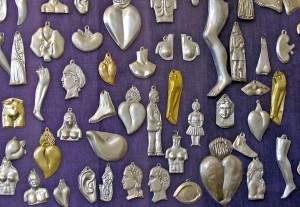The healthiness of each individual is whole, extending to and including our illnesses. As we move from healthiness to unhealthiness – we might become ill. Sometimes, illness can attack even the healthiest person.
“Every illness can be cured. No disease can be cured”. – The Healthicine Creed.
Does that make sense? Or nonsense? Let’s look more closely. An illness is what the patient has. Disease is what the doctor diagnoses. Most of the time, when we are ill, we don’t have a diagnosis, don’t have a disease. A disease is a name given to a group of illnesses, with similar symptoms. Different cases of the same disease might have totally different causes, and thus require very different cures.
The World Health Organization classifies diseases according to the ICD10, International Classification of Diseases Version 10, and is currently working on version 11.
The ICD 10 classifies diseases into three categories, and encourages worldwide classification of all disease as:
- communicable diseases, HIV, TB, etc.
- non communicable diseases : hypertension, breast cancer, etc.
- external causes of injuries : traffic accident, drowning.
Diagnosis is the process of mapping an illness, a specific case of illness, to a disease – a class of illnesses. Every illness changes, first growing, and then possibly shrinking as time passes. A diagnosis occurs at specific points in time. Different diseases might be diagnosed from the same illness, at different points in time, or even at the same point in time by different physicians. An illness is a hole in your health, an invisible hole in your health, that cannot be seen, or touched, even as it grows and shrinks. We can only see the causes, and the consequences – the symptoms. As a result, diagnosis is always a challenge.
The ICD10 does not classify illnesses, only diseases. An illnesses cannot be classified until it is diagnosed as a disease. Once diagnosed, it can be classified – even if the diagnosis is incorrect. Of course if the diagnosis is incorrect – the classification is also incorrect. Many diagnoses are incorrect. A mis-diagnosis occurs when a physician recognizes that a prior diagnosis was incorrect and updates the diagnosis.
The ICD10 classification system is a powerful and useful tool that sets a stage for further analysis. However, in actual implementation, the ICD 10 strays into details that fail to comprehend the big picture. Diseases are not actually grouped into these categories – and are instead grouped sometimes by cause, sometimes by the body part or bodily system affected, even sometimes by specific life events – pregnancy, for example. I think this happens because in medicine because diseases are first classified into categories developed by the long, complex history of medicine, and then grouped into the ICD10 categories.
We can make excellent use of the initial framework with three classes of disease. We need to first deal with the main groups, and their names. Communicable diseases, non communicable diseases and injuries are weak names that show little about what each encompass – and what each does not encompass.
Communicable diseases are diseases caused by living entities that attack our health – as part of their nature, their urge to live and reproduce. A more appropriate classification name is Parasitic Diseases.
Non-communicable diseases are a completely different type of diseases, caused by lack of healthiness, or by unhealthiness. We could name them ‘unhealthiness diseases’ but that phrase has significant stigma, which might create confusion. A more appropriate name is Healthiness Diseases – diseases caused by imbalances or deficiencies in healthiness.
The final classification name, Injury Diseases is entirely appropriate, although we don’t often think of injuries as ‘diseases’ – the word disease is loosely defined and entirely appropriate for classification and study purposes.
Disability: The World Health Organization uses another classification system for disabilities – using a completely different model, the International Classification of Functioning, Disability and Health (ICF). There is, of course, considerable overlap between classifications of diseases and classifications of disabilities. There is no clear distinction between a disability and a disease, and the classification of disabilities is used for different purposes.
In healthicine, a disability is a dysfunction that cannot be cured. If it can be cured, or if it is cured, it is no longer a disability.
The three classifications of diseases – in the healthicine model, are therefore Parasitic Diseases, Healthiness Diseases and Injury Diseases. This provides a powerful framework – more comprehensive than the ICD10 for studying illness and disease. It is important, at this point, to reiterate the distinction between an illness and a disease.
An illness is a specific case of illness, in a specific patient. Even a single patient might get several colds throughout their lifetime – each is an illness – an individual case of an illness. A disease is a name, a classification given to a group of illnesses to facilitate study, understanding, prognosis and treatment – and World Health Organization statistics. An illness might be cured – but a disease, a group of related illnesses, cannot be ‘cured’.
Even with the clear main categories of parasitic diseases, healthiness diseases, and injury diseases – there is plenty of room for confusion to arise. All diseases can cause injuries. Injuries to the body often allow entry of parasitic diseases. Lack of healthiness can also lead to injuries, and thus to the entry of parasitic diseases. Parasitic diseases can result in lower levels of healthiness.
At first glance, it’s a big mess. We need to work to make sense of this. We might try to classify diseases by cause. Application of the correct classification requires identification of the cause – but many diagnostic and treatment techniques do not rely on cause. In many cases, especially for injuries, treatment must commence immediately and cause is barely relevant except for studies of prevention.
Cancers are a special case. Is a cancer a parasitic disease, or a lack of healthiness? Modern medical treatments assume that cancers are a parasitic disease and respond by attempting to ‘kill’ the parasite. No physician looks for ’cause’ in individual cases. This may be one reason for the failure of most treatments for cancers. Cancers can be caused by radiation – an injury, by parasites – viruses, or by toxic chemicals – an unhealthy environment that results in an unhealthy body. We might someday learn that some cancers need to be treated as parasitic diseases – while others are best treated as healthiness diseases. This distinction is not acknowledged by today’s cancer treatment centers, much less acted upon.
Physicians often have difficulty identifying cause – even when they are very successful at treating the disease. Most treatments, most ‘successful treatments’ according to current medical science, do not aim to cure the disease, rather to treat symptoms of disease. Treating symptoms does not require knowledge of cause.
To cure an illness, and know it has been cured, requires identification of cause – except for injury diseases. In all three classifications of disease, knowledge of cause is required for preventative measures. Today’s studies of causes, for many diseases, are statistical – not actual causes of specific illnesses in specific patients. This results in much statistical noise and nonsense. Everything causes cancers, everything prevents cancers. An American Journal of Clinical Nutrition meta-study found that wine, tomatoes, tea, milk, eggs, corn, coffee, butter, and beef have been found to contribute to cancer, and to prevent cancers, in different research studies.
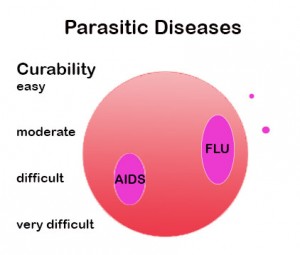
Let’s look at parasitic diseases, for example, a bit closer.
Each Parasitic Disease is actually a collection of specific illnesses, in individual patients. Each parasitic disease, from influenza to AIDS, to measles, to being bitten by a tiger, is caused by a living entity, which grows and evolves. Each individual case of an illness is caused by specific living entities.
The living entities cause illnesses with different effects on different people, more or less severe, more or less curable, sometimes even resulting in different symptoms from the same ‘disease’. We should expect that some parasitic illnesses have not yet been understood, not yet been classified into diseases. It is also possible, because these are living entities, for new parasitic entities to evolve from nature – and those might not be classified as disease agents for some time.
It is important to be clear about that: the parasite is NOT the illness. The measles virus is not the measles illness. An individual illness is also not ‘the disease’. The disease is a name, collection, a classification system for similar illnesses, designed to facilitate treatment and prevention.
With the name Parasitic Disease it’s easy to assume that the parasite is a small ‘communicable’ entity. But it doesn’t take long to identify a parasitic disease that is caused by a large entity, perhaps a tiger, or even a human. When we take our analysis of disease above the body, to the communities, we can see that kidnapping, robbery, murder, are all parasitic diseases. It is possible for an illness to be parasitic to parasitic, which we might call ‘co-dependency’. Is co-dependency also recognized as a disease? The ICD10 prefers diseases of individuals – and does not recognize diseases of communities. It lists ‘mental and behavioral disorders’, but does not have a classification for co-dependency. The ICD10 operates on the assumption that a disease can only affect a single individual. An illness however, might affect a group of people – a mob, for example.
Each Healthiness Disease encompasses a set of similar healthiness illnesses – cases of unhealthiness. Each healthiness illness is caused by a lack of healthiness. We often think of a lack of healthiness as an ‘imbalance’. It is more correct to think of it as ‘inability to balance’. Living entities use balancing to progress in life. Just as we fall forward and recover our balance to move forward, even uphill – there are many other acts of balance in life. When any of them becomes less than functional – healthiness drops, congestion or deficiency can result, leading to illness. Our ability to maintain balance, and to use balance to move forward in life, can be adequate – at the level of ‘wellness’ or ‘not-sickness’, or it can be exceptional, or it can be deficient – leading to illness.
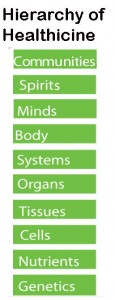 How many Healthiness Diseases are there? How many healthiness illnesses? We can some insight by reviewing the hierarchy of healthicine, which spans genetics, nutrients, cells, tissues, organs, bodily systems, body, minds, spirits, and communities. At each layer, there are many factors of healthiness – leading to many possible unhealthinesses and many different illnesses. These illnesses are most often grouped in categories according to the body part affected. Some diseases, or meta-diseases, like cancer, cover huge areas of illness.
How many Healthiness Diseases are there? How many healthiness illnesses? We can some insight by reviewing the hierarchy of healthicine, which spans genetics, nutrients, cells, tissues, organs, bodily systems, body, minds, spirits, and communities. At each layer, there are many factors of healthiness – leading to many possible unhealthinesses and many different illnesses. These illnesses are most often grouped in categories according to the body part affected. Some diseases, or meta-diseases, like cancer, cover huge areas of illness.
There are many, many more possible healthiness illnesses than there are names for healthiness diseases. Many bodily system dysfunctions have similar consequences, resulting in a common disease name. There might be hundreds of causes for an ‘overactive thyroid’, for example – but the result is only a single disease, from the perspective of diagnosis, prognosis – and even treatment of symptoms.
It is only necessary to distinguish individual causes if it is our intent to cure. Most of today’s medicines do not attempt to cure, because diseases of healthiness cannot be cured by medicines. Cause is often ignored to facilitate ‘treatments’ that do not cure.
Every illness is more unique, more individual than a diagnosis or disease classification. Every cure is unique. Only an illness can be cured. We cannot cure a ‘classification group’, a disease nor a meta-disease.
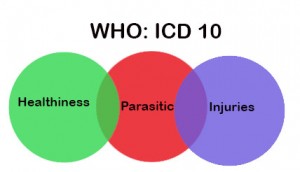 One feature of this disease classification system, is the overlap between classifications. For example, we all have symbiotic bacteria and fungi as part of our healthy bodies. In certain situations, these can change from symbiotic to parasitic, or from parasitic to symbiotic. A healthy condition, a healthy symbiotic bacteria, can overgrow and create an unhealthy condition – which might be classified as a parasitic disease, or as a healthiness disease. The same can happen with the injuries category. A parasitic bacteria, or a parasitic tiger can cause an injury. Is it a parasitic disease, or an injury?
One feature of this disease classification system, is the overlap between classifications. For example, we all have symbiotic bacteria and fungi as part of our healthy bodies. In certain situations, these can change from symbiotic to parasitic, or from parasitic to symbiotic. A healthy condition, a healthy symbiotic bacteria, can overgrow and create an unhealthy condition – which might be classified as a parasitic disease, or as a healthiness disease. The same can happen with the injuries category. A parasitic bacteria, or a parasitic tiger can cause an injury. Is it a parasitic disease, or an injury?
In these cases, it might be more appropriate to use the ‘treatment’ as a guideline for classification. We need to step back and ask ourselves “What is the goal of the classification?” From the World Health Organization’s perspective the goal is accurate calculation and presentation of disease statistics, which can be used to prepare plans to prevent and fight disease.
However, I am not interested in the World Health Organization goals, my objectives are to understand, and to improve our understanding with a solid foundation and classification system, that evolves as we learn more.
When we look at the overlap in the diagram above, we can see that all three classifications of disease, parasitic, healthiness diseases and injury diseases have many common features and issues:
- each classification group has sets of diseases, with different curability features
- each disease group contains illnesses that are similar
- each has the potential for illnesses that have not yet been given names, much less classifications and disease categories
- each disease category has overlap with the others
- each disease within each category has variation with regards to ease, or difficulty of curability and other factors.
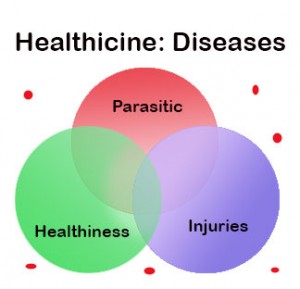 This can create confusion with regards to treatments and cures. A single ‘disease’ can have many different causes, and the correct cure can differ based on cause. A cure for some patients might actually make other patients more ill – even though they have the same ‘disease name’. This gets more complex when the illness is mis-diagnosed or mis categorized.
This can create confusion with regards to treatments and cures. A single ‘disease’ can have many different causes, and the correct cure can differ based on cause. A cure for some patients might actually make other patients more ill – even though they have the same ‘disease name’. This gets more complex when the illness is mis-diagnosed or mis categorized.
An illness might be due to a combination of factors, and treating any one of the factors – even if they are in different categories, can lead to a cure. An illness caused by lack of healthiness, or injury, allowing ongoing attack by a parasite, might be cured by attacking or removing the parasite, or by raising healthiness such that the parasite cannot mount a successful attack. It’s not difficult to think of many other examples of overlap or even movement between the classification groups. But the groups provide very useful information with regards to cures.
Modern medicine pays scant attention to cures. For the most part, the focus is on ‘treatments’ not on cures. Each disease in the classification system has a range of curability, which denotes our ability to cure individual cases, individual illnesses of that disease. Actual curability depends not just on the disease, but also on the cause, and also on the patient.
Many of today’s treatments for diseases simply do not cure, and are not designed to cure. Many diseases are identified as ‘incurable’ by one party or another. The source of this confusion is found in these categories.
There is a main type of cure for each category of disease.
Parasitic illnesses are cured by removing or addressing the parasite. This might be accomplished by raising healthiness such that the parasite is no longer a danger. Surgery and medicines are common parasitic cures. In those cases the cure may require attention by a physician. Modern medicine has mixed success against parasitic illnesses. We can fight some with antibiotics, some even with amputations, but these actions can be dangerous. We have some success at prevention of parasitic illnesses using techniques ranging from simple cleanliness to complex vaccinations.
Healthiness illnesses are cured by raising healthiness, such that the illness is no longer present. These illnesses are slow and difficult to cure. They generally cannot be cured by a physician, rather they must be cured by the patient, typically be adding, changing, or removing a life habit. Healthiness cures challenge our habits – dietary habits, exercise habits, mental, spiritual and community habits, because the illness is a result of ongoing unhealthiness – often of unhealthy habits. A physician can offer advice, but the patient must implement the cure. The patient must believe in the cure. These illnesses are very poorly addressed by modern medicine, which often attempts to treat them with ‘medicines’, ignoring the fact that they are caused by a lack of healthiness. Many treatments for these illnesses treat symptoms only and in many cases can cause more damage than the disease itself. As far as I am aware, there is not a single healthiness illness, or ‘non communicable illness’ in ICD10 categories, for which there is a well defined cure. If a cure occurs for a ‘non communicable illness’, modern medicine has no technique to recognize the patient as ‘cured’. Why? Because ‘things’, eg. medicines and medical treatments, cannot cure diseases caused by lack of healthiness.
Injury illnesses are cured by healing. Injury illnesses are generally well treated by emergency medicine. This is the area where modern medicine excels. The emergency room of every hospital is always busy, and very effective. Medical treatments act quickly – exactly what is required for injury illnesses. Heart disease – a healthiness illness, is very difficult for modern medicine. But when it comes to a crisis, and a heart attack – an injury illness – occurs, modern medicine is able to act quickly and effectively. However, treatments for injury illnesses often stop short of healing. A medical injury, a medical crisis, often results in ‘patching up the patient’ and sending them home to heal, with little support or guidance other than a “don’t do this” list. Medical rehabilitation centers focus attention on healing, but many patients never encounter rehabilitation, and are expected to heal on their own.
Most injury illnesses are minor, are not presented to a doctor, not diagnosed as a disease. We have a cut, we put on a bandaid. We get bruised, and it heals naturally. However, for most injury illnesses, even minor ones, complete healing is not possible. The damage that accumulates and cannot be healed, or are not healed, are the effects we call aging.
Every illness causes damage that requires healing to complete a cure. Parasitic illnesses cause damage, some of which might never be completely healed. Healthiness illnesses cause damage, some of which might never be completely healed.
Natural Cures: Many illnesses are naturally cured by healthiness. We often think of the common cold, a parasitic illness, as incurable. But the illness of a common cold is easily cured by health and by time. When the patient’s healthiness is lower, healthiness cures take longer.
Confusion arises because of our preference to give ‘credit’ for the cure. Does the doctor cure? Does the medicine cure? Does the ‘saint’, the mystic, the shaman, the witch, cure the disease? Are illnesses cured by magic?
There is no need for magic in the science of medicine. There are no ‘spontaneous remissions’, no ‘spontaneous cures’. Every cure has a cause. Every illness is cured by improving the healthiness of the patient. Every true cure results in a healthier patient.
In summary
Illness includes all dysfunctions or disruptions of functioning throughout the entire hierarchy of healthicine including many that are too minor to be diagnosed by a medical doctor.
Every illness is a single, specific case, affecting an entity. That entity might be a cell, a tissue, a bodily system, a body… or even a community.
Diseases are the names given to groups of illness for diagnostic purposes. Every specific case of a diagnosis is a specific underlying case of an illness. The disease is not the illness, it is the name given at diagnosis, to facilitate the development of a prognosis and treatment.
There are three main categories of disease classification, and three main categories of illness:
Parasitic illnesses – where a parasite feeds on or disrupts the health of a living entity.
Healthiness illnesses – which are caused by a lack of healthiness.
Injuries – which can be caused by external factors, or by parasitic or healthiness illnesses.
There are three types of cures for illness and disease. Parasitic cures stop the progress of the parasite, and thus the progress of the illness. Healthiness cures improve healthiness and the illness fades away. Healing cures provide recovery from the illness. When only partial healing is possible, the result is aging.
Different illnesses may require different types of cures – and many illnesses require several types of cures for optimal, complete recovery.
Aging is the accumulation of damage to the body, the mind, the spirit, or the community, caused by illness, that cannot be, or is not healed.
Every illness can be cured. With science, and diligence, every cure can be understood.
to your health, tracy
Tracy is the author of two books about healthicine:

